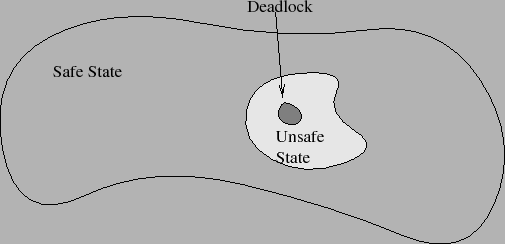Deadlock II
Tom Kelliher, CS 311
Apr. 2, 2012
Exam in one week.
Deadlock I.
- Deadlock detection and recovery.
- Deadlock avoidance.
- Summary.
Linux kernel modules.
- Permit deadlocks to occur, subsequently recover from them.
- Periodically run deadlock detection routines.
- Choose victim processes.
Algorithmic deadlock detection:
 processes.
processes.
 resource types.
resource types.
- Available -- vector of length
 .
.
- Allocation -- matrix of size
 by
by  . Rows: processes; columns:
resources.
. Rows: processes; columns:
resources.
- Request -- matrix of size
 by
by  .
.
- Finish -- vector of length
 .
.
- Work -- vector of length
 .
.
The algorithm:
work = available;
for (i = 0; i < n; ++i)
finish[i] = false;
while there is an i such that finish[i] == false
and request[i] <= work
{
finish[i] = true;
work = work + allocation[i];
}
- Running time?
- How often should this be run? What are the tradeoffs?
- Any processes for which finish is false are deadlocked.
Using a resource allocation graph to detect deadlock (5 processes, 3
resource types):
Retry with this request matrix:
Some recovery mechanisms:
- Terminate all deadlocked processes. What about threads (say
only some of the threads in a task are deadlocked)?
- Terminate processes one at a time.
- How do you choose the victim?
- When do you stop terminating victims?
- ``Rolling back'' a process and preempting resources.
- Process termination is drastic and messy.
- Checkpoints.
- How much state has to be checkpointed?
- Starvation.
Always maintain the system in a safe state:
Grant a resource request only if resulting state is safe.
Safe state:
- There exists a sequence in which all resource requests can be
satisfied.
- The operating system is in control of the resource situation.
Unsafe state:
- The operating system is no longer in control of the resource
situation.
- Processes are in control and can cause a deadlock.
Banker's algorithm used to maintain safe state.
Additional matrix required: Claim -- maximum number of each resource type
needed by each process.
For each resource request which can be satisfied
{
simulate:
satisfy the request;
update state matrices;
turn all remaining claims into requests;
test for deadlock;
if simulation resulted in deadlock
defer the request;
else
grant the request;
}
Assume a maximum-claim serially reusable system with four processes and
three resource types. The claim matrix is given by
where  denotes the maximum claim of process
denotes the maximum claim of process  for resource
for resource  .
The total units of each resource type are given by the vector
.
The total units of each resource type are given by the vector  .
The allocation of resources is given by the matrix
.
The allocation of resources is given by the matrix
where  denotes the number of units of resource
denotes the number of units of resource  that are
allocated to process
that are
allocated to process  .
.
- Determine if the current state of the system is safe.
- Determine if granting a request by process 1 for 1 unit of resource 1 can
be safely granted.
- Determine if granting a request by process 3 for 6 units of resource 3 can
be safely granted.
- Some resources are easy to keep out of deadlock: CPU cycles, memory.
- No one ``silver bullet'' -- must combine mechanisms.
- Must tradeoff between cost of protection and cost of deadlock.
Thomas P. Kelliher
2012-04-02
Tom Kelliher
![\begin{displaymath}
{\rm Allocation} = \left[ \begin{array}{rrr}
0 & 1 & 0 \\
...
...
3 & 0 & 3 \\
2 & 1 & 1 \\
0 & 0 & 2
\end{array} \right]
\end{displaymath}](apr02img4.png)
![\begin{displaymath}
{\rm Request} = \left[ \begin{array}{rrr}
0 & 0 & 0 \\
2 ...
...
0 & 0 & 0 \\
1 & 0 & 0 \\
0 & 0 & 2
\end{array} \right]
\end{displaymath}](apr02img5.png)
![\begin{displaymath}
{\rm Request} = \left[ \begin{array}{rrr}
0 & 0 & 0 \\
2 ...
...
0 & 0 & 1 \\
1 & 0 & 0 \\
0 & 0 & 2
\end{array} \right]
\end{displaymath}](apr02img6.png)

![\begin{displaymath}
C = \left[
\begin{array}{rrr}
4 & 1 & 4 \\
3 & 1 & 4 \\
5 & 7 & 13 \\
1 & 1 & 6
\end{array}\right],
\end{displaymath}](apr02img8.png)
![\begin{displaymath}
A = \left[
\begin{array}{rrr}
0 & 1 & 4 \\
2 & 0 & 1 \\
1 & 2 & 1 \\
1 & 0 & 3
\end{array}\right],
\end{displaymath}](apr02img13.png)